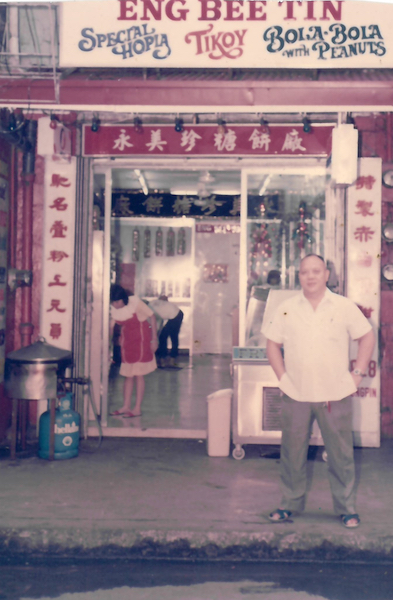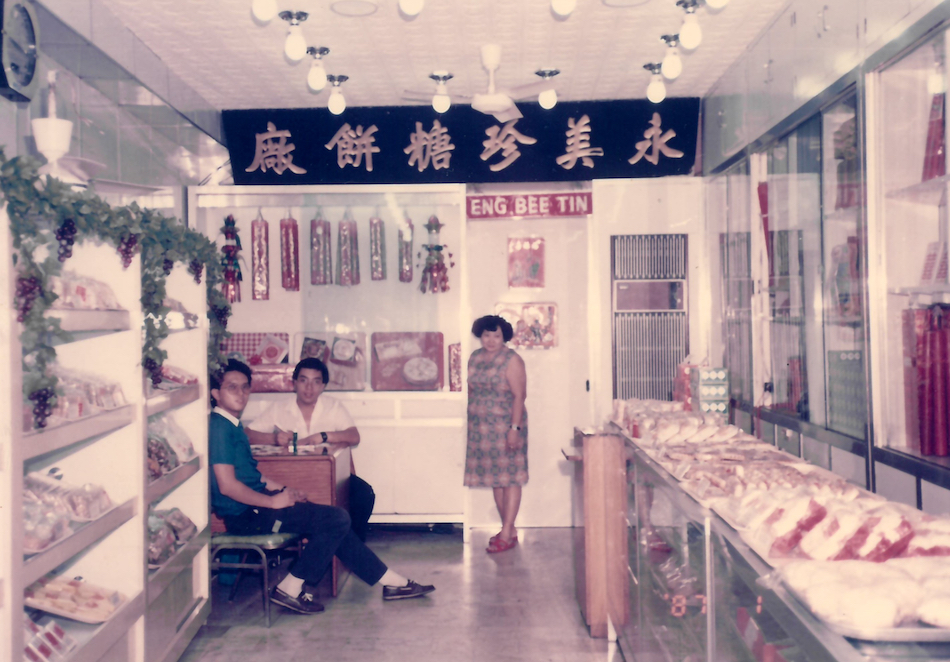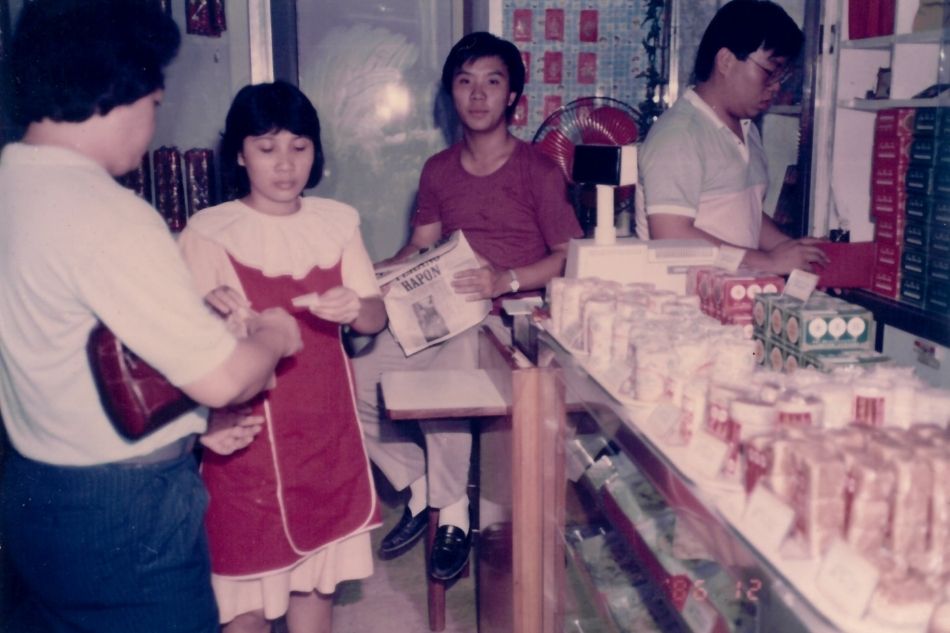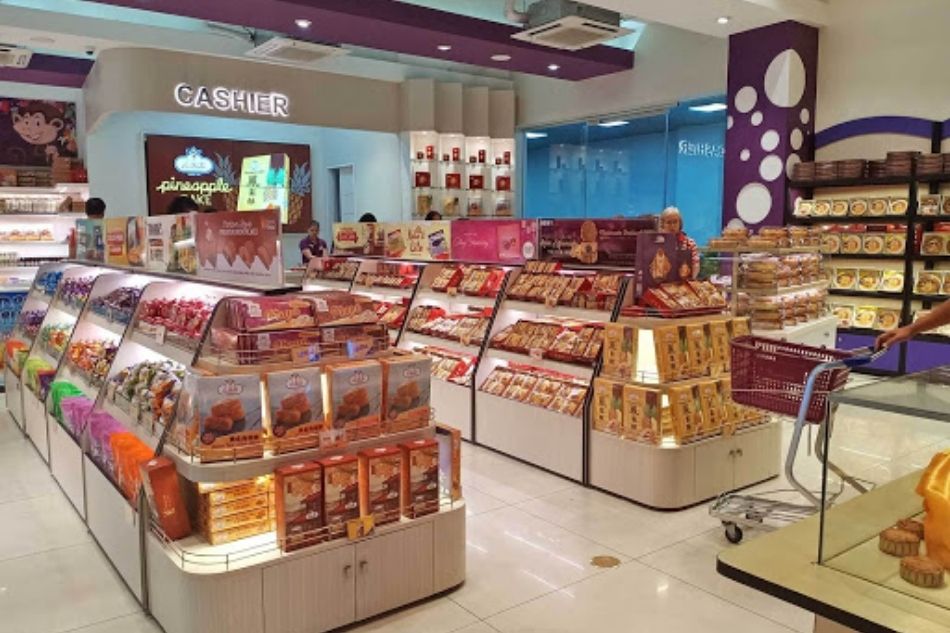The Chuas of Eng Bee Tin: The family that sells and eats tikoy together | ABS-CBN

Welcome, Kapamilya! We use cookies to improve your browsing experience. Continuing to use this site means you agree to our use of cookies. Tell me more!
The Chuas of Eng Bee Tin: The family that sells and eats tikoy together
The Chuas of Eng Bee Tin: The family that sells and eats tikoy together
RHIA GRANA
Published Feb 06, 2021 02:26 PM PHT
|
Updated Feb 06, 2021 02:52 PM PHT
Chinese New Year is always the busiest time for the Chuas, the family behind Eng Bee Tin, one of the enduring Chinese delicacy brands in the country. In fact, it took a while for us to get hold of Gerik Chua, who’s now heading its business operations. The new generation of Chuas are now in charge: that means Gerik, brother Gerald, who’s handling the production, and sister Geraldyn, who is taking care of finances.
Chinese New Year is always the busiest time for the Chuas, the family behind Eng Bee Tin, one of the enduring Chinese delicacy brands in the country. In fact, it took a while for us to get hold of Gerik Chua, who’s now heading its business operations. The new generation of Chuas are now in charge: that means Gerik, brother Gerald, who’s handling the production, and sister Geraldyn, who is taking care of finances.
Gerik is the eldest in the brood, and is already the fourth-generation owner of the Chinese deli chain. His great grandfather, Chua Chiu Hong, from Xiamen, China, founded the business in 1912, calling it Eng Bee Tin, or “ever beauty precious” in Hokkien. It all started in a small store along Nueva St. in Binondo.
Gerik is the eldest in the brood, and is already the fourth-generation owner of the Chinese deli chain. His great grandfather, Chua Chiu Hong, from Xiamen, China, founded the business in 1912, calling it Eng Bee Tin, or “ever beauty precious” in Hokkien. It all started in a small store along Nueva St. in Binondo.
The business was later on inherited by the son Menito, who handed it over to Gerry, Gerik’s father. Gerry took over the business at a time when prospects were dim, stepping up at the young age of 16 in the hopes of saving the struggling bakery from collapsing. The family was hard on cash and deep in debt. “Eight checks a day yung nagbabounce, kasi yung tatay ko, ginawa nang pera ‘yung tseke,” Gerry shared in a Rappler feature in 2018. “Galing eskwelahan, pag-uwi ko kailangang magtanong sa bangko kung magkano utang namin.”
The business was later on inherited by the son Menito, who handed it over to Gerry, Gerik’s father. Gerry took over the business at a time when prospects were dim, stepping up at the young age of 16 in the hopes of saving the struggling bakery from collapsing. The family was hard on cash and deep in debt. “Eight checks a day yung nagbabounce, kasi yung tatay ko, ginawa nang pera ‘yung tseke,” Gerry shared in a Rappler feature in 2018. “Galing eskwelahan, pag-uwi ko kailangang magtanong sa bangko kung magkano utang namin.”
The mom-and-pop bakery sold a variety of Chinese treats for decades, but their hopia and tikoy were the quintessential moneymakers. Back then, hopia only came in two flavors—baboy and monggo, and as for the tikoys, there were only white and brown.
The mom-and-pop bakery sold a variety of Chinese treats for decades, but their hopia and tikoy were the quintessential moneymakers. Back then, hopia only came in two flavors—baboy and monggo, and as for the tikoys, there were only white and brown.
ADVERTISEMENT
Gerik credits his father for establishing the brand’s foothold by coming up with innovative ideas—offering new flavors and upgrading their packaging. They were the first to popularize the ube-flavored hopia, which helped save the business at one point. (Gerry recalled to Rappler that he got the idea from an ice cream vendor he met in Ongpin.)
Gerik credits his father for establishing the brand’s foothold by coming up with innovative ideas—offering new flavors and upgrading their packaging. They were the first to popularize the ube-flavored hopia, which helped save the business at one point. (Gerry recalled to Rappler that he got the idea from an ice cream vendor he met in Ongpin.)
As for the packaging, Eng Bee Tin used to just place a sheet of plastic on top of their tikoy, which made it easy for the sweet Chinese cake to gather mold—unless preservatives were used in the tikoy mixture. “Kami, we don’t put preservatives in our products, kaya kami ang unang nag-vacuum pack ng tikoy para tumagal," says Gerik. "Ngayon naging standard na sya [sa industriya],” says Gerik.
As for the packaging, Eng Bee Tin used to just place a sheet of plastic on top of their tikoy, which made it easy for the sweet Chinese cake to gather mold—unless preservatives were used in the tikoy mixture. “Kami, we don’t put preservatives in our products, kaya kami ang unang nag-vacuum pack ng tikoy para tumagal," says Gerik. "Ngayon naging standard na sya [sa industriya],” says Gerik.
Starting young
Starting young
To hear the young owner say it, there is nothing romantic or cinematic about making their famous tikoy. “Actually, ang pag-gawa ng tikoy is very simple, especially now that the other steps are already automated," says Gerik. “You just mix the rice powder with the sugar, water, flavoring and then we already have a machine that puts the mixture in moulds. Then we have a steamer that fits about 400 tikoys.”
To hear the young owner say it, there is nothing romantic or cinematic about making their famous tikoy. “Actually, ang pag-gawa ng tikoy is very simple, especially now that the other steps are already automated," says Gerik. “You just mix the rice powder with the sugar, water, flavoring and then we already have a machine that puts the mixture in moulds. Then we have a steamer that fits about 400 tikoys.”
Gerik and his siblings were introduced to the family business quite early. After school, or when there were no classes, they would watch the store. “Ganoon kami na-bring up,” says the eldest of the brood. During Chinese New Year, when foot traffic was expectedly high, they would help out in selling the goods or would be tasked to be in charge of the kaha.
Gerik and his siblings were introduced to the family business quite early. After school, or when there were no classes, they would watch the store. “Ganoon kami na-bring up,” says the eldest of the brood. During Chinese New Year, when foot traffic was expectedly high, they would help out in selling the goods or would be tasked to be in charge of the kaha.
Passed down to them were not only recipes but important formulas to gain customer loyalty. One tip he learned from his father, Gerik says, is to be customer-centric—to never ever let the customer feel short-changed. This starts with their food. “We only use high-quality ingredients. Hindi kami nagsa-substitute ng mumurahin. Di bale nang maliit ang kita, ang mahalaga, babalik-balikan ka.” He points out the superior qualities of their tikoy, for example. “Mapapansin mo ang tikoy namin makapal, tama ang mga timbang, malagkit pero di dumidikit sa kawali.” Other tikoys melt, he says, and stick to the frying pan when cooked.
Passed down to them were not only recipes but important formulas to gain customer loyalty. One tip he learned from his father, Gerik says, is to be customer-centric—to never ever let the customer feel short-changed. This starts with their food. “We only use high-quality ingredients. Hindi kami nagsa-substitute ng mumurahin. Di bale nang maliit ang kita, ang mahalaga, babalik-balikan ka.” He points out the superior qualities of their tikoy, for example. “Mapapansin mo ang tikoy namin makapal, tama ang mga timbang, malagkit pero di dumidikit sa kawali.” Other tikoys melt, he says, and stick to the frying pan when cooked.
ADVERTISEMENT
According to Gerik’s dad, so long as you satisfy your customers, the profit will follow.
According to Gerik’s dad, so long as you satisfy your customers, the profit will follow.
Sticky situation
Sticky situation
The Chuas put a premium on innovation and creativity, which is most likely one of the reasons why they are still around after over 100 years. “Kami ang nag-start ng iba-ibang flavors ng tikoy—ube, pandan, strawberry, sweet corn—yan ang first four flavors na ginawa namin. Kami rin ang unang naglabas ng tikoy na four flavors in one box. Kami rin ang gumawa ng tikoy na sugar-free for diabetics. Kami rin ang gumawa ng savory na tikoy—salted egg, minced pork, chorizo, salted fish,” he says.
The Chuas put a premium on innovation and creativity, which is most likely one of the reasons why they are still around after over 100 years. “Kami ang nag-start ng iba-ibang flavors ng tikoy—ube, pandan, strawberry, sweet corn—yan ang first four flavors na ginawa namin. Kami rin ang unang naglabas ng tikoy na four flavors in one box. Kami rin ang gumawa ng tikoy na sugar-free for diabetics. Kami rin ang gumawa ng savory na tikoy—salted egg, minced pork, chorizo, salted fish,” he says.
To equip himself with the skills needed to continually innovate and propel the business, Gerik studied different courses in the US and Taiwan—baking science, Chinese pastry, and business.
To equip himself with the skills needed to continually innovate and propel the business, Gerik studied different courses in the US and Taiwan—baking science, Chinese pastry, and business.
Tikoy is not a mere sweet treat for the Chuas. It’s always present on their dining table during Chinese New Year because it symbolizes many things: a sweet life; prosperity, harmony and balance, because of its round shape; and close family ties because of its stickiness.
Tikoy is not a mere sweet treat for the Chuas. It’s always present on their dining table during Chinese New Year because it symbolizes many things: a sweet life; prosperity, harmony and balance, because of its round shape; and close family ties because of its stickiness.
Over a hundred years have passed, and many things may have changed, but the Chuas continue to gather over some tikoy during Chinese New Year. “Ang essence kasi ng celebration na ito is family,” says Geric, “magsama-sama, magkuwentuhan, kumain together.” It looks like the tikoy continues to work it’s wonders.
Over a hundred years have passed, and many things may have changed, but the Chuas continue to gather over some tikoy during Chinese New Year. “Ang essence kasi ng celebration na ito is family,” says Geric, “magsama-sama, magkuwentuhan, kumain together.” It looks like the tikoy continues to work it’s wonders.
ADVERTISEMENT
Photos courtesy of Gerik Chua
Photos courtesy of Gerik Chua
Read More:
anc
ancx
ancx.ph
abs-cbn
abs-cbn news
food and drink
features
eng bee tin
chinese new year
CNY 2021
ADVERTISEMENT
ADVERTISEMENT







